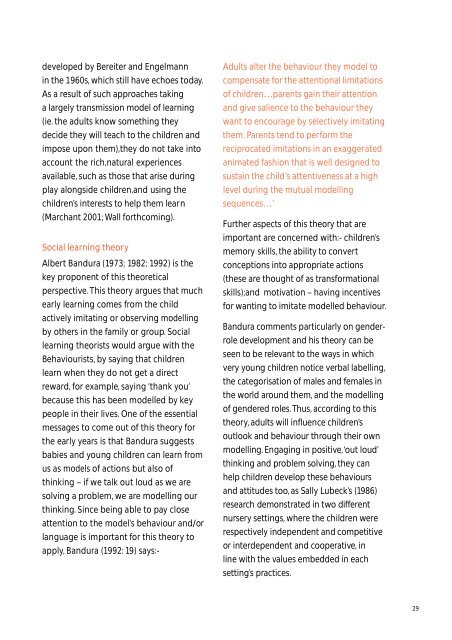Birth to three matters - Communities and Local Government
Birth to three matters - Communities and Local Government
Birth to three matters - Communities and Local Government
You also want an ePaper? Increase the reach of your titles
YUMPU automatically turns print PDFs into web optimized ePapers that Google loves.
developed by Bereiter <strong>and</strong> Engelmannin the 1960s, which still have echoes <strong>to</strong>day.As a result of such approaches takinga largely transmission model of learning(ie. the adults know something theydecide they will teach <strong>to</strong> the children <strong>and</strong>impose upon them),they do not take in<strong>to</strong>account the rich,natural experiencesavailable, such as those that arise duringplay alongside children,<strong>and</strong> using thechildren’s interests <strong>to</strong> help them learn(Marchant 2001; Wall forthcoming).Social learning theoryAl be rt Ba n d u ra (1973; 1982 ; 1992) is thekey pro po n e nt of this theore t i ca lpe r s pe ct i ve. This theory argues that muche a rly learning comes from the childa ct i ve ly i m i t a t i n g or observing m od e l l i n gby others in the family or gro u p. Soc i a ll e a rning theorists would argue with theBe h av i o u ri s t s, by saying that childre nl e a rn when they do not get a dire ctrewa rd, for ex a m p l e, s ay i n g ‘thank yo u’be cause this has been modelled by keypeople in their live s. One of the essent i a lmessages <strong>to</strong> come out of this theory fo rthe early years is that Ba n d u ra suggestsbabies <strong>and</strong> young children can learn fro mus as m od e l s of actions but also oft h i n king – if we talk out loud as we ares o lving a pro b l e m , we are modelling ourt h i n ki n g. Si n ce being able <strong>to</strong> pay closeat te ntion <strong>to</strong> the mod e l’s be h aviour <strong>and</strong>/orlanguage is impo rt a nt for this theory <strong>to</strong>a p p ly, Ba n d u ra (1992: 19) says :-Adults alter the behaviour they model <strong>to</strong>compensate for the attentional limitationsof children…parents gain their attention<strong>and</strong> give salience <strong>to</strong> the behaviour theywant <strong>to</strong> encourage by selectively imitatingthem. Parents tend <strong>to</strong> perform thereciprocated imitations in an exaggeratedanimated fashion that is well designed <strong>to</strong>sustain the child’s attentiveness at a highlevel during the mutual modellingsequences…’Further aspects of this theory that areimportant are concerned with:- children’smemory skills, the ability <strong>to</strong> convertconceptions in<strong>to</strong> appropriate actions(these are thought of as transformationalskills);<strong>and</strong> motivation – having incentivesfor wanting <strong>to</strong> imitate modelled behaviour.Ba n d u ra co m m e nts part i c u l a rly on genderroledeve l o p m e nt <strong>and</strong> his theory can beseen <strong>to</strong> be re l eva nt <strong>to</strong> the ways in whichve ry young children notice verbal labe l l i n g,the cate g o ri s ation of males <strong>and</strong> females inthe wo rld around them, <strong>and</strong> the mod e l l i n gof gendered ro l e s.Th u s, a c co rding <strong>to</strong> thist h e o ry, adults will influence childre n’so u t l ook <strong>and</strong> be h aviour through their ow nm od e l l i n g. Engaging in po s i t i ve,‘out loud’t h i n king <strong>and</strong> problem solv i n g, t h ey ca nhelp children develop these be h av i o u r s<strong>and</strong> attitudes <strong>to</strong>o, as Sa l ly Lu be c k’s (19 86 )re s e a rch demonstrated in two diffe re ntn u r s e ry settings, w h e re the children we rere s pe ct i ve ly indepe n d e nt <strong>and</strong> co m pe t i t i veor inte rd e pe n d e nt <strong>and</strong> coo pe rat i ve, inline with the values embedded in eachs e t t i n g’s pra ct i ce s.29
















